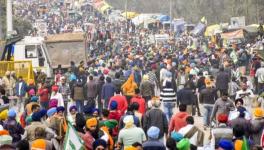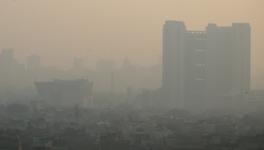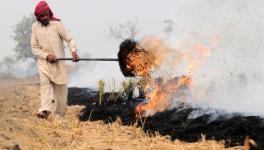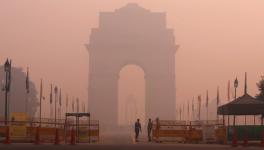Why the Stubble Burning Problem Refuses to Go Away

Image Courtesy: PTI
It is 7 am, but the sun is hiding. The sky is an ash grey, and my throat itches. I can feel a traffic jam in my sinuses as they fill with allergens—fuel vapours, smoke and perhaps stubble soot too. I know it is a terribly polluted November, and yet the corporate media flashes on our screens that the ‘pollution and stubble-burning is lower’. A smoke-filled post-Diwali morning said otherwise.
Each Diwali, we trot out the usual scapegoats for our pollution problem: chemical paddy farmers in Punjab and Haryana. Burnt, charred fields are flashed by news channels, blaming farmers for the mess. Yet truth can be stranger than fiction. Various studies have confirmed that stubble burning is episodic and the fourth top contributor to the toxified winter air in north India. The tops ones are vehicular pollution, construction and industrial pollution, including brick klins that dot the countryside.
Stubble Trouble?
Stubble burning is a consequence of chemical monocultures that have been forced upon Punjab for the last five decades. A fertile water-rich region was made to transform into a factory that produces agri-commodities wheat and rice. In the 1960s, less than 5% of the cultivated area in Punjab was under paddy. Today, 84% of the Kharif crop area is under paddy cultivation.
Most farmers in Punjab and Haryana have living memories of how government scientists and agri-experts persuaded them to adopt chemical agriculture and “diversify” into monocultures of paddy and wheat. The stubble of traditional paddy varieties such as Basmati is not burnt, as their straw is used for cattle fodder. However, the newer Green Revolution varieties are not edible and changing economic and industrial conditions have left farmers with no alternative use for them.
As stubble burning is quick and efficient, farmers got hooked to it. They have to clear their fields to prepare them for the next harvest. Now, there are not just one or two, but three harvests a year. Every day counts in this tight schedule, as farmers strive for every last drop of their falling income from their fields. It is the reason why stubble burning has continued unabated since the 1970s. Once combined harvesters came into the scene in Punjab, Haryana and parts of Uttar Pradesh, manual harvesting decreased, and the stubble problem increased. The new agri-harvesters cannot cut the straw deep enough into the ground. So, after the harvests, straw stubbles stood firm, sticking out of the earth inches or even a foot high. It requires an additional cost to get the field cleared manually or through other machines. Burning the straw is much easier.
After seeding the stubble problem, the policymakers sprang into action. They offered even more farm machinery such as Happy Seeder and Super Seeder as solutions, laying the ground for the following problem. For, the state dud not properly manage the support for the machinery to manage the straw at the village level. The government’s own estimates confirm that there are not enough Happy Seeders, mulchers, etc., to cover the entire Punjab region. Add astronomically high fuel costs, and the farmers have been thoroughly discouraged from renting or buying these machines.
In rural Punjab, it costs over Rs. 2,500 per acre to clear the paddy straw. Small farmers’ meagre incomes cannot support such an operation. Buying agri-machinery is a bigger hassle as the government provides subsidies only to a handful of listed agencies. The farmers do not have the choice to buy a cheaper machine or adopt a more efficient alternative such as the modified rotavator, which costs Rs.18,000-25000 (compared with Rs. 1.75 lakh for the Happy Seeders).
The higher straw management machines require 60HP-plus tractors, which are rare in the countryside. If the farmers want a super seeder, they will need to buy a new higher power tractor. That would mean making all the farm tools they own redundant. A farmer would need to change the whole farming ecosystem before adopting these machines. For this reason, only large and wealthy farmers can afford this makeover. It is the government that has to come to the aid of smaller farmers, instead of offering peacemeal solutions like sprays, to tackle stubble.
Farmers in the Punjab-Haryana region have also complained about corporate interference in shaping subsidy policies. If we compare the price inflation on these machines, most farmers have complained that since the government announced the subsidy, prices of agri-machineries increased too. A Happy Seeder, which earlier cost Rs. 1 lakh, was now in the territory of Rs. 1.75 lakh.
The stubble burning problem increases each year because of bad policy. Policymakers are not listening to the farmers and what they want. Instead, they are trying to impose their ‘solutions’ on them, which we have seen repeatedly, fail to catch farmers’ attention.
And are there alternatives to manual clearing of fields and the machines? Yes, it is possible to move away from funding agri-machinery manufacturers and giving farmers cash to clear stubble fields. That would stop stubble burning and give people a few days of farm work as well. Factoring in inflation, and the time and fuel costs saved, farmers would be more than happy to stop burning stubble.
The second step can be to shift from paddy into farming that is more organic and genuinely diversified. Every chemical farmer earns relatively more on the Kharif paddy produce. However, if we factor in the rising input costs, the net profit from the produce is still relatively less. This is what forces them to hurry along with the preparation of their fields for the next harvest. The ecological and water costs involved in the current system of farming is destroying Punjab’s fields. It is another reason for farmers to get price support for at least three years while they shift out of paddy cultivation.
To ensure that real-time incomes are not affected during the three years, farmers should get incentives to get organic certification and re-learn the craft of multi-cropping. Organic produce fetches four times higher prices than regular chemical crops, and it is also beneficial for the soil and the health of farmers. Even a shift to oilseeds or legumes with organic certification can get them similar margins. It is for this reason that crop diversification is a demand of the farmers from Punjab.
We need to move Punjab from growing agri-commodities into growing food. It may come as a surprise, but rural Punjabi households consume very little rice. Yet, the entire state produces it. This is an artificially sustained system based on the destruction of soil, water and society.
Solutions such as gasification or paddy straw briquettes for thermal plants have also been doing the rounds, but they are as unviable as the government’s Happy Seeder project. By going towards these industrial solutions, policymakers are seeding the next problem in Punjab. In addition, straw should be mulched into the soil. In his rice fields in Japan, the father of modern-day natural farming, Masanobu Fukuoka, has demonstrated the importance of mulching straw and how farmers are losing their most precious fertilisers by burning straw. Even in Punjab, new voices are emerging that are choosing these natural farming methods over stubble burning. The last alternative to stubble burning is activities such as mushroom cultivation. Paddy straw is extensively used as raw material by mushroom growers. Various varieties of mushrooms, such as paddy straw mushrooms, oysters, etc., grow well on paddy straw and can be raised by farmers to boost their nutrition and incomes.
That said, all these arrangements can work to an extent. The only long-term feasable solution to straw-stubble burning is for the state to support low cost and low tech machinery that manages the straw at the village level and help farmers towards growing crops suited to their Agro-climatic zones. An DBT policy linked to paddy procurement is also need to have ensure all farmers supplying to the government system are not burning stubble and in return are getting price support for straw management.
The author is an independent policy analyst and writer on agriculture and the environment. The views are personal.
Get the latest reports & analysis with people's perspective on Protests, movements & deep analytical videos, discussions of the current affairs in your Telegram app. Subscribe to NewsClick's Telegram channel & get Real-Time updates on stories, as they get published on our website.
























